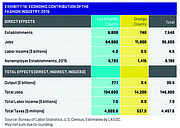FINANCE
Jobs in the Creative Industries Take a Big Step Forward in California
Over the past five years, the creative economy in California has seen a growth spurt as more jobs have been added in the sector’s core areas of entertainment, fashion and publishing.
According to a recent report commissioned by the Otis College of Art and Design, the Los Angeles region accounts for the bulk of the state’s creative jobs.
In 2016, the latest year for which there are statistics, Los Angeles County accounted for 399,500 creative-industry jobs, which increased nearly 13 percent over a five-year period, making up more than half the 789,800 statewide creative jobs.
And that number will only get bigger. Over the next five years, creative-jobs employment is expected to rise by 8.1 percent in Los Angeles County, and in Orange County it will inch up 2.8 percent over the same period. California should see a 5.6 percent jump in creative-sector jobs.
In the report, the creative economy covers 12 major areas that range from architecture, interior design and the apparel industry to furniture making, decorative arts, toys and, of course, the entertainment industry.
“Almost all of California’s major industry sectors added jobs in 2017 and will do so again over the next 10 to 24 months,” said the report, prepared by the Los Angeles County Economic Development Corp. and released on May 22. “Rising employment and higher wages will benefit sectors that rely on consumer spending, including art galleries, fashion, entertainment, toys, the visual and performing arts, and digital media. Likewise, improvements in the housing market will boost activity for architectural firms and interior designers and increase demand for furniture and the decorative arts.”
In California, the bulk of the creative jobs are in entertainment (192,200), publishing and printing (160,300), and fashion (120,800). Together, these three industries accounted for 60 percent of the direct jobs in California’s creative industries.
“What we saw is that the overall health in our economy is good and the creative economy is such an important component of that,” said Somjita Mitra, the director of the LAEDC’s Institute for Applied Economics, who was the principal author of the report. She noted that 50 percent of the creative jobs in California require at least a bachelor’s degree to enter a profession, which means they are highly skilled professions that pay much more than the minimum wage.
Bruce Ferguson, president of the Otis College of Art and Design, pointed out that taking into account the trickle-down effect of the jobs, the creative economy generated 1.6 million jobs, directly and indirectly, with workers earning $141.5 billion.
In the fashion industry, the bulk of the jobs for apparel design, manufacturing and wholesaling are concentrated in the Los Angeles area, but there is still a significant presence in San Francisco, home to Levi Strauss & Co. and Gap Inc. as well as several indie clothing companies manufacturing in the Bay Area.
Although apparel manufacturing in the state has declined, design-related activity strongly contributes to maintaining the apparel industry’s presence in California as well as wholesale jobs. Also, there are a number of well-respected fashion-design schools in the state that are turning out a number of successful designers.
In 2016, there were 120,800 jobs in the fashion industry, up slightly from the 120,100 jobs seen in 2011. By 2021, however, that is expected to shrink to 105,600 jobs as apparel-manufacturing opportunities continue to move out of the region to countries where labor is cheaper.
The salary range for workers in the creative industry varies widely. In Los Angeles County, applications software developers were at the top of the list, earning $111,128. Other handsomely paid workers are in the entertainment industry. Producers and directors have an annual median income of $97,493 and film and video editors are right up there with a median wage of $95,494.
Fashion designers in Los Angeles County had an annual median income of nearly $70,000, and fabric and apparel patternmakers earned a median salary of nearly $50,000.
In Orange County, the wages for the fashion industry were slightly different. Fashion designers earn about $60,000 a year and patternmakers make nearly $68,000, according to the Otis report.






















